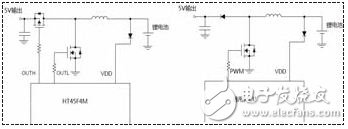1 Introduction With the popularity of global smartphones and tablets driven by iphone and ipad, a smart phone is no longer a distant dream. Mobile phones and tablets are essential items for people to go out, in addition to communication, camera and computer functions. In addition, these digital devices are also a fashion embodiment. The pursuit of the perfect shape of lightweight and slim is in contradiction with the battery life. In pursuit of perfection, iphone and ipad are designed to be an unremovable fuselage for integrated users. The battery cannot be disassembled, so mobile power has become a necessity for digital backup power, and its market demand has rapidly expanded with the development of smart devices. 2. Program analysis 2.1 Technical specifications and program comparison The current mainstream mobile power supply for mobile phone tablets is: (1) It has a lithium battery charge and discharge management function; (2) 5V/500mA/1A/2A output. Among them, lithium battery charge and discharge management is realized by “protection IC+ASIC or MCUâ€, and 5V/500mA/1A/2A output is realized by lithium battery Boost boost plus feedback control. In the mobile voltage scheme, the most critical indicator and technical difficulty is the efficiency of Boost boost output, because the lithium battery charging power source generally comes from the 220V mains charger, no special emphasis on efficiency, and Boost boost is the battery power. Output to mobile phones, tablets, charging efficiency is particularly important. Taking the mobile power supply at 10000 mA as an example, 90% efficiency and 70% efficiency of the Boost charging circuit, the output power difference is 2000 mAh. From the user experience, the low-efficiency mobile power supply has a serious heat generation and a large safety hazard. There are two main types of Boost circuits, one is diode free-wheeling Boost, the circuit is relatively simple, one is synchronous Boost, the circuit is relatively complicated, and the precision of control timing is high. In the past few years, due to strong demand, in order to quickly ship, a large number The scheme uses the Boost scheme of diode freewheeling, and the price war is very intense. Therefore, high-end manufacturers began to move to the synchronous Boost scheme. 2.2 Synchronous Boost Scheme for Dedicated MCUs The mobile power MCU HT45F4M solution is a synchronous Boost solution widely used in the market. It has the characteristics of simple circuit and high efficiency. The technical indicators provided by the original manufacturer are: static power consumption is less than 10uA, and the measured discharge conversion efficiency is over 91% (5V). /700mA output). Lithium battery protection mechanism: over-current over-voltage protection. The schematic diagram of the synchronous Boost and the diode freewheeling Boost are shown in Figure 1. Figure 1 HT45F4M synchronous Boost and general-purpose MCU diode free-flow Boost comparison As can be seen from Figure 1, the main feature of the HT45F4M compared with the general-purpose MCU is the built-in complementary PWM output function. By controlling the PWM complementary timing of OUTL and OUTH, the NMOS and PMOS are controlled to be turned on and off, thus achieving synchronous Boost. We have measured the finished product of the scheme, and the efficiency is basically the same as that provided by the manufacturer. Compared with the diode Boost scheme, when the high current is above 1A, the power device has low heat generation, obvious difference in effect, and good performance. Double Concave Cylindrical Lens
Double concave Cylindrical Lens has two outward surfaces.
Cylindrical lenses are typically applied to focus incoming light to a line, or to change the aspect ratio of an image. they are used for the optics, lasers, medical science, electronics, tele-communication and others.
Double Concave Cylindrical Lens,Fused Silica Concave Cylindrical Lens,Double Concave Cylindrical Lenses,Cylindrical Lense Changchun Realpoo Photoelectric Co., Ltd. , https://www.optics-realpoo.com
Specifications:
Material : N-BK7, N-SF1 , Fused Silica , N-SF10 etc
Diameter : 2mm ~ 300mm
Focal Legnth Tolerance :+/-1%
Diameter Tolerance :+0.0/-0.1mm
Thickness Tolerance :+/-0.1mm
Surface Quality :40/20 or better
Centration :<3 arc minutes
Clear Aperture :>90%
Bevel : Protective bevel as needed
Coating :Upon your request